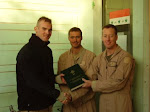
The joy and peace of the Lord Jesus Christ, born for us this day, be with you!
The following is the customary reading for Christmas from the Roman Martyrology, often proclaimed prior to the celebration of Christmas Mass at Midnight: In the year 5199 since the creation of the world, when God made Heaven and earth; in the year 2759 since the flood; in the year 2015 since Abraham’s birth; in the year 1510 since the exodus of the people of Israel from Egypt under the guidance of Moses; in the year 1032 since David was anointed king. In the 65th week of the year according to Daniel’s prophecy; in the 194th Olympiad, in the year 732 after the building of Rome; in the 42nd year of the reign of Octavian Augustus, when there was peace in the whole world; in the sixth era of the world’s history; Jesus Christ, eternal God and Son of the eternal Father, desired to sanctify the world by His gracious coming.
He was conceived by the power of the Holy Spirit, and now after nine months ( all kneel).
He is born at Bethlehem in the tribe of Judah as Man from the Virgin Mary.
The Birth Of Our Lord Jesus Christ In The Flesh.
To aid your prayerful meditation in this joyous feast of Christmas I offer the following treasures of doctrine from the Catechism of the Catholic Church.
“ Belief in the true Incarnation of the Son of God is the distinctive sign of Christian faith: ‘ By this you know the Spirit of God: Every spirit which confesses that Jesus Christ has come in the flesh is of God.’ Such is the joyous conviction of the Church from her beginning whenever she sings ‘ the mystery of our religion’: ‘ He was manifested in the flesh’” ( n. 463).
"The unique and altogether singular event of the Incarnation of the Son of God does not mean that Jesus Christ is part God and part man, nor does it imply that He is the result of a confused mixture of the divine and the human. He became truly man while remaining truly God. Jesus Christ is true God and true man. During the first centuries, the Church had to defend and clarify this truth of faith against the heresies that falsified it” ( n. 464).
"Taking up St. John’s expression, ‘ The Word became flesh,’ the Church calls ‘ Incarnation’ the fact that the Son of God assumed a human nature in order to accomplish our salvation in it. In a hymn cited by St. Paul, the Church sings the mystery of the Incarnation: “ ‘ Have this mind among yourselves, which is yours in Christ Jesus, who, though He was in the form of God, did not count equality with God a thing to be grasped, but emptied Himself, taking the form of a servant, being born in the likeness of men. And being found in human form He humbled Himself and became obedient unto death, even death on a cross’ ( Phil. 2: 5- 8)” ( n. 461).
"The veneration of sacred images is based on the mystery of the Incarnation of the Word of God. It is not contrary to the First Commandment” (n. 2141).
"Because 'human nature was assumed, not absorbed,’ in the mysterious union of the Incarnation, the Church was led over the course of centuries to confess the full reality of Christ’s human soul, with its operations of intellect and will, and of His human body. In parallel fashion, she had to recall on each occasion that Christ’s human nature belongs, as His own, to the divine person of the Son of God, who assumed it. Everything that Christ is and does in this nature derives from ‘ one of the Trinity.’ The Son of God therefore communicates to His humanity His own personal mode of existence in the Trinity. In His soul as in His body, Christ thus expresses humanly the divine ways of the Trinity: “‘The Son of God . . . worked with human hands; He thought with a human mind. He acted with a human will, and with a human heart He loved. Born of the Virgin Mary, He has truly been made one of us, like to us in all things except sin’ ( Gaudium et Spes, 22: 2)” ( n. 470).
Sincere wishes for a most blessed and joy-filled Christmas celebration to all of our readers and their families!
(Photo: Image of the Bambino Gesu, the Christ Child, in the crib at the Basilica of Saint Peter's, Rome.)











No comments:
Post a Comment